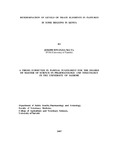| dc.description.abstract | Trace elements are needed by ruminant animals for physiological and biochemical
processes. The trace elements at optimum levels make animals to maintain desired
production performance parameters. Excesses of some of these trace elements can also
lead to toxicosis. The important trace elements are copper, cobalt, zinc and selenium.
The present study was conducted to determine levels of copper, cobalt, zinc,
and selenium in known pasture grasses from eight regions of Kenya; to establish
whether the named trace elements are deficient or in toxic quantities; to relate
the trace element levels from the pasture grasses from different regions of Kenya
with known recommended values in mg/kg of dry matter (mg/kg of DM) for
optimum livestock production, and finally to recommend any intervention
measures.
Forage samples (n = 171) were collected from eight regions in Kenya during
months of July and August 2005. These regions were: Coast province, Machakos
district, Nairobi province, Kiambu district, Mount Kenya region, Nakuru district,
Eldoret region and Homabay district. The pasture grasses collected were: kikuyu grass,
napier grass, red oats grass, star grass, sweet pitted grass, common setaria, brown
hood grass and sudan grass. The samples were then transported to the laboratory.
The grass samples (20 grams) were chopped into one-centimetre pieces and oven
dried for 48 hours at 600C. They were then ground using Willey mill no. 20 stainless
steel sieve and allowed to equilibrate with the atmospheric pressure for 12 hours and
mixed properly pending assay for trace elements. Nine validation assay techniques
were conducted, correlation coefficients determined, and the technique that gave the
highest positive correlation, (R2) value of 0.997, with a regression equation of,
Y=0.046 + 0.021X, was adopted in the isolation and quantification of trace
ents from the sample matrix. A linear regression curve was fitted for the
technique. Constituent trace elements (Co, Cu, Zn, and Se) were separated from the
organic matrix using wet oxidation, with the digestion chemicals being nitric acid and
perchloric acid at the ratio of 3:1 respectively. The trace elements were assessed using
Perkin-Elmer model 2380 flame atomic absorption spectrophotometer at the following
wavelengths: 327.4 nm, 240.7 nm, 213.9 nm, and 196.0 nm for copper, cobalt, zinc,
and selenium respectively. Mean (mg/kg of DM) ± SD national values for zinc,
copper, selenium and cobalt were 44.1 ± 20.5, 4.2 ± 1.6, < 0 and 4.4 ± 6.3 respectively.
These values were found to be below the nutritional requirements for optimum
livestock production for copper, zinc and selenium and suggestive of a deficiency,
while fifty percent (50%) of all the regions investigated had cobalt levels that
were observed to be below the normal recommended values for optimum
livestock production, and were found to be deficient of the trace element.
Deficiency was shown in 68% of pastures for copper, 62% of pastures for zinc,
in 61% of pastures for cobalt and in 42% of pastures for selenium.
The results of the current study indicate that more than fifty eight percent of
grass in the studied areas are deficient of all the trace elements investigated, and
intervention measures, such as trace element supplementation is required. The pasture
grasses from the eight regions studied do not accumulate toxic levels of the
trace elements studied. | en |

